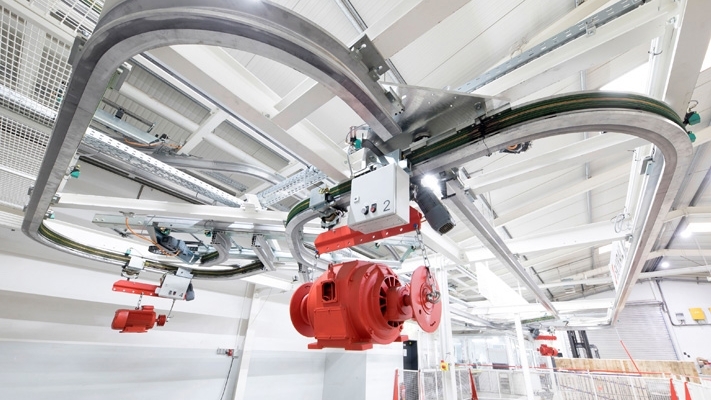Electric monorail systems (EMS) are primarily known as conveyor technology in the automotive industry, where they are used for transporting car bodies or at assembly stations. However, their properties offer advantages for many other industries. These include the food and beverage industry, wood, metal and glass production and processing, logistics centers in the building materials or furniture industry, airports and others. "When using an EMS, a company must always calculate the cost-benefit factor. This includes planning, system and installation costs as well as the running costs for operation and maintenance," says Holger Schmidt. He manages the Ostrhauderfehn site of SEH Engineering GmbH, which specializes in conveyor technology.
EMS are suitable wherever companies transport heavy or large, unwieldy goods or picked goods. Their characteristics such as freedom of movement, variable speeds, low-noise operation and high flexibility in terms of track layout are significant advantages over chain or roller conveyor systems. This results in enormous versatility in the system design, which is complemented by an infinite number of load handling equipment options. The vehicles not only bridge large spatial distances via the rails, they also move individually in the rails and can therefore take different transport routes. This allows users to separate individual production pieces for different processing, for example. Rail routes with ascending and descending sections are also possible, enabling work on several levels or bringing the goods to a work-friendly height at assembly or picking stations. The vehicles communicate with each other to prevent collisions and are operated via a central control system.
Standard SRMs to C1 standard are standardized in components, vehicles and rails and move loads of up to 1500 kg per vehicle. "This is necessary for the automotive industry and other productions with heavy loads. However, many companies do not need this load design at all, but would have to bear the corresponding costs for system material and steel construction for suspension if they invested in such an EMS," explains Holger Schmidt. More cost-effective alternatives such as cardan and plug-in chain conveyors are not always the ideal solution if the production environment requires clean, quiet, low-maintenance and intelligent conveyor technology. For goods weighing up to 800 kg, for example, SEH now offers a more cost-effective solution with Skyrail®. Due to a special development of the rails, this EMS is a lighter version of the large C1 systems, which reduces the costs of the system by up to 40 percent.
Another advantage: systems that do not fall under the C1 standard can be planned and built much more individually.
Schmidt explains: "In terms of cost-effectiveness, reliability and safety, innovative EMSs are in no way inferior to standard systems, but we have found, particularly in the SME sector, that individual solutions and components are often required, as well as an optimal, budget-friendly price-performance ratio. As we manufacture the core components of our conveyor technology ourselves in our factory, we at Skyrail can implement additions or special solutions very flexibly and at short notice." Consistent implementation of the common parts principle, a rail span of up to six meters, the internal rotor principle without brackets and struts on the steel structure and plug-in connectors for easy assembly reduce costs, as do modern planning principles such as predictive engineering.


